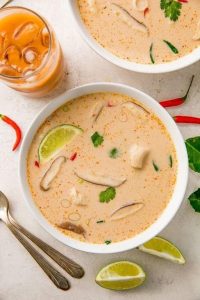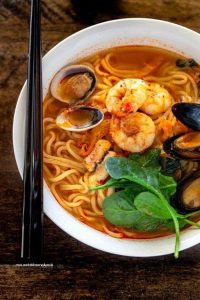Embark on a culinary journey to the heart of Gujarat with our roundup of 20 Delicious Gujarati Food Recipes Authentic to your kitchen! Whether you’re craving the comfort of a homemade Dhokla or the tangy zest of Khandvi, these recipes promise to bring the vibrant flavors of Gujarat to your table. Perfect for home cooks in North America looking to spice up their meal rotation. Let’s get cooking!
Dhokla
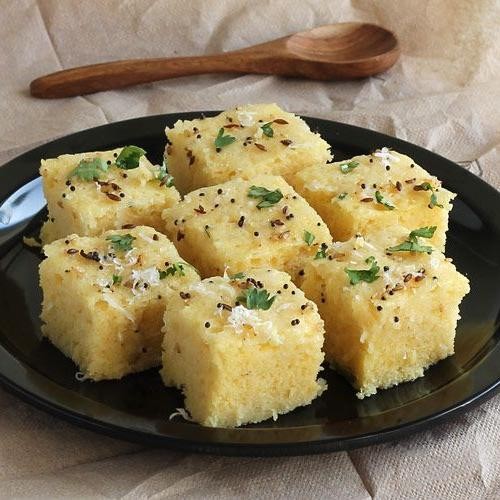
Fluffy, light, and subtly tangy, Dhokla is a steamed Gujarati delicacy that’s as nutritious as it is delicious, offering a perfect balance of flavors and textures that delight the palate.
Ingredients
- For the batter:
- 1 cup gram flour (besan)
- 1 tbsp semolina (sooji)
- 1 tsp ginger-green chili paste
- 1/2 tsp turmeric powder
- 1 tbsp lemon juice
- 1 cup water
- 1 tsp fruit salt (eno)
- For tempering:
- 2 tbsp oil
- 1 tsp mustard seeds
- 1 tsp sesame seeds
- 2-3 green chilies, slit
- 1/2 cup water
- 2 tbsp sugar
- 1/4 cup fresh cilantro, chopped
- 1/4 cup grated coconut
Instructions
- In a large bowl, combine gram flour, semolina, ginger-green chili paste, turmeric powder, lemon juice, and water to form a smooth batter. Let it rest for 10 minutes.
- Grease a steaming tray with oil and set aside. Just before steaming, add fruit salt to the batter and mix gently to incorporate.
- Pour the batter into the prepared tray and steam over medium heat for 15 minutes, or until a toothpick inserted comes out clean.
- While the dhokla steams, heat oil in a small pan for tempering. Add mustard seeds, sesame seeds, and green chilies, sautéing until the seeds pop.
- Add water and sugar to the tempering, stirring until the sugar dissolves. Pour this tempering over the steamed dhokla immediately after it’s done.
- Garnish with chopped cilantro and grated coconut. Allow it to cool slightly before cutting into pieces.
Offering a soft, spongy texture with a hint of sweetness and spice, Dhokla is best served warm, paired with tangy tamarind chutney or simply enjoyed on its own as a light snack.
Thepla
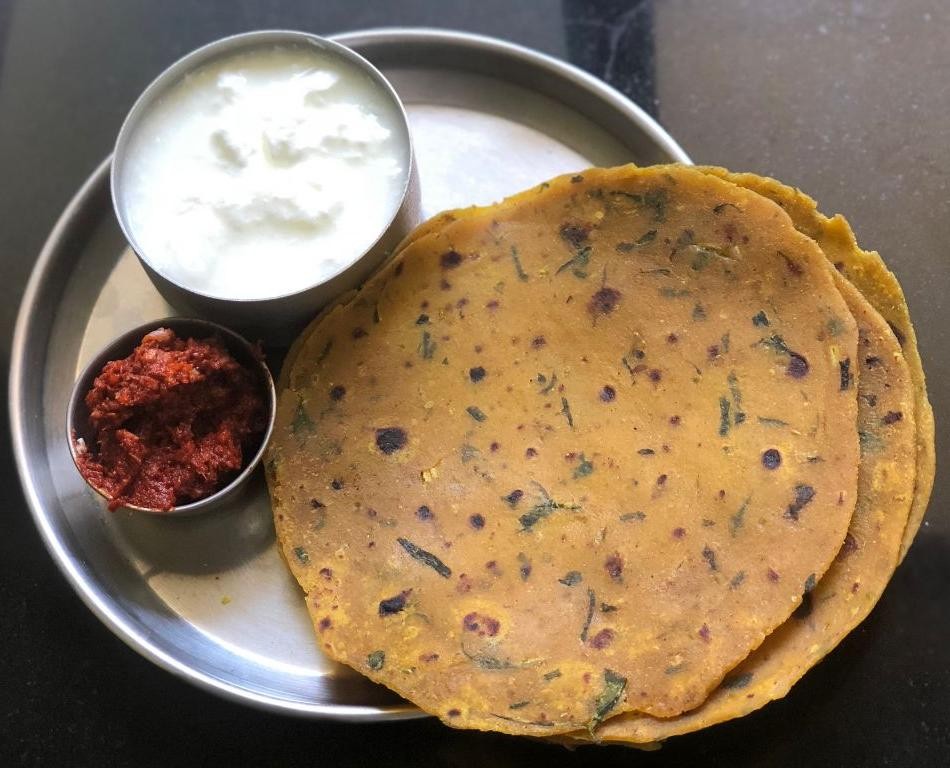
Amidst the bustling flavors of Indian cuisine, Thepla stands out as a versatile flatbread that marries the earthy tones of whole wheat with the vibrant zest of spices, offering a delightful canvas for both simple and elaborate meals.
Ingredients
- For the dough:
- 2 cups whole wheat flour
- 1/2 cup besan (gram flour)
- 1/4 cup yogurt
- 1 tbsp oil
- 1/2 tsp turmeric powder
- 1/2 tsp red chili powder
- 1/2 tsp cumin seeds
- Salt to taste
- Water as needed
- For cooking:
- 2 tbsp oil
Instructions
- In a large mixing bowl, combine whole wheat flour, besan, turmeric powder, red chili powder, cumin seeds, and salt. Mix well to ensure the spices are evenly distributed.
- Add yogurt and 1 tbsp oil to the dry ingredients. Gradually add water, kneading into a soft, pliable dough. Cover and let it rest for 15 minutes to allow the gluten to relax.
- Divide the dough into equal-sized balls. On a lightly floured surface, roll each ball into a thin, round disc, about 6 inches in diameter.
- Heat a tawa or skillet over medium heat. Place a rolled thepla on it and cook for about 30 seconds until small bubbles appear.
- Flip the thepla and spread 1/2 tsp oil on the cooked side. Cook for another 30 seconds, then flip again and spread oil on the other side. Press lightly with a spatula to ensure even cooking.
- Cook until both sides are golden brown and crispy, about 1-2 minutes per side. Repeat with the remaining dough balls.
Soft yet slightly crisp, Thepla boasts a harmonious blend of spices that elevate its humble ingredients. Serve warm with a side of pickle or yogurt for a comforting meal, or pack it for a flavorful travel companion.
Khandvi
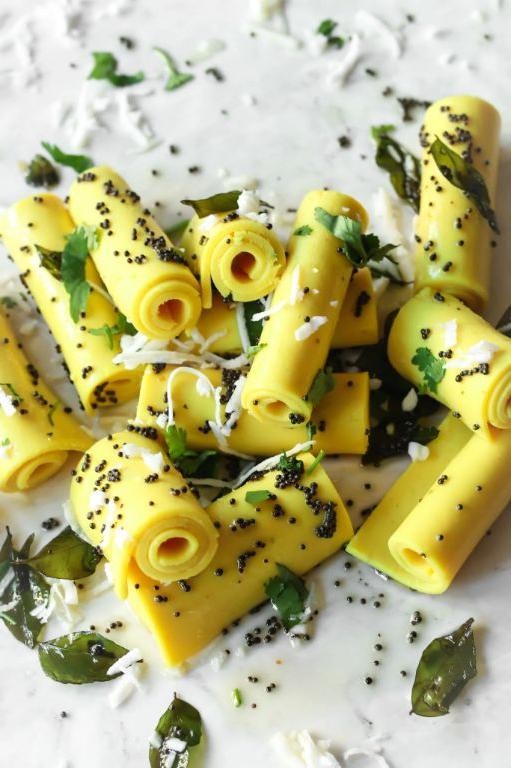
Perfectly delicate and subtly spiced, Khandvi is a Gujarati delicacy that rolls out like a thin sheet of savory goodness, offering a melt-in-the-mouth experience with every bite. This dish, a testament to the simplicity and elegance of Indian cuisine, combines gram flour and yogurt into a smooth batter, then artfully rolls it into bite-sized pieces adorned with mustard seeds and fresh cilantro.
Ingredients
For the batter:
- 1 cup gram flour (besan)
- 1 cup plain yogurt
- 2 cups water
- 1/2 teaspoon turmeric powder
- 1/2 teaspoon ginger paste
- Salt to taste
For the tempering:
- 2 tablespoons vegetable oil
- 1 teaspoon mustard seeds
- 2 green chilies, finely chopped
- 10-12 curry leaves
- 2 tablespoons fresh cilantro, chopped
- 1/4 teaspoon asafoetida (hing)
Instructions
- In a large mixing bowl, whisk together gram flour, yogurt, water, turmeric powder, ginger paste, and salt until smooth and free of lumps.
- Transfer the batter to a non-stick pan and cook over medium heat, stirring continuously, for about 10-12 minutes or until the batter thickens to a paste-like consistency. Tip: The batter is ready when it leaves the sides of the pan.
- Quickly spread the hot batter onto a greased surface or the back of a greased baking tray in a thin, even layer using a spatula. Tip: Work swiftly to spread the batter before it cools and sets.
- Allow the spread batter to cool for about 5 minutes, then cut into 2-inch wide strips and roll each strip tightly into a spiral. Tip: Use a butter knife to help lift the edges for rolling.
- For the tempering, heat oil in a small pan over medium heat. Add mustard seeds and let them pop, then add green chilies, curry leaves, and asafoetida, sautéing for 30 seconds.
- Drizzle the tempering over the rolled Khandvi and garnish with chopped cilantro.
These Khandvi rolls boast a silky texture with a tangy undertone, perfectly balanced by the aromatic tempering. Serve them as an elegant appetizer or a light snack, perhaps accompanied by a sweet and spicy chutney for an extra layer of flavor.
Undhiyu
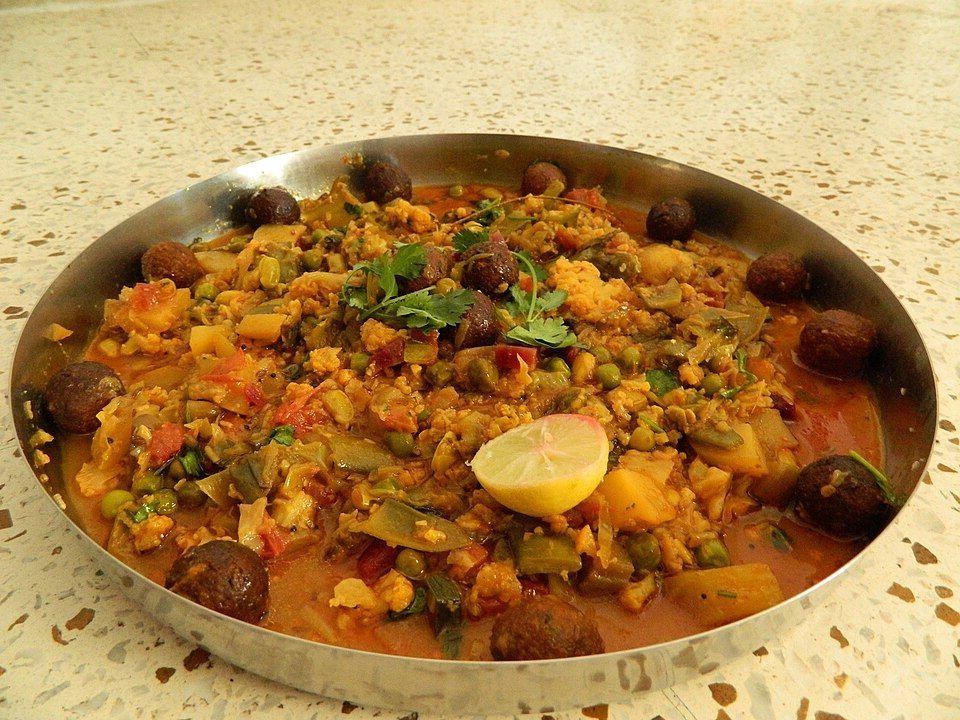
Combining the vibrant flavors of Gujarat, Undhiyu is a winter specialty that brings together an array of seasonal vegetables and spices, slow-cooked to perfection. This one-pot wonder is a celebration of textures and tastes, offering a delightful harmony of sweet, spicy, and savory notes.
Ingredients
- For the vegetable mix:
- 1 cup purple yam (cubed)
- 1 cup sweet potatoes (cubed)
- 1 cup green beans (chopped)
- 1 cup small eggplants (slit)
- 1/2 cup fresh pigeon peas
- For the spice paste:
- 1/4 cup fresh cilantro (chopped)
- 1/4 cup fresh garlic (minced)
- 2 tbsp ginger (minced)
- 1 tbsp green chili paste
- 1 tsp turmeric powder
- 2 tbsp lemon juice
- For cooking:
- 3 tbsp vegetable oil
- 1/2 tsp asafoetida
- 1 tsp mustard seeds
- 1/2 cup water
- Salt to taste
Instructions
- In a large bowl, combine all the vegetables for the mix and set aside.
- Prepare the spice paste by blending cilantro, garlic, ginger, green chili paste, turmeric, and lemon juice into a smooth paste.
- Heat oil in a heavy-bottomed pan over medium heat. Add asafoetida and mustard seeds, waiting until the seeds crackle for about 30 seconds.
- Add the spice paste to the pan, sautéing for 2 minutes until fragrant.
- Introduce the vegetable mix to the pan, stirring well to coat each piece with the spice paste.
- Pour in water, cover the pan, and simmer on low heat for 30 minutes, stirring occasionally to prevent sticking.
- Check for salt, adjusting if necessary, and cook uncovered for an additional 10 minutes to thicken the sauce.
- Remove from heat and let it rest for 5 minutes before serving.
Nowhere does comfort food get as colorful and hearty as with Undhiyu, its tender vegetables melting in your mouth amidst a richly spiced gravy. Serve it with warm rotis or steamed rice for a meal that’s as nourishing as it is flavorful.
Fafda
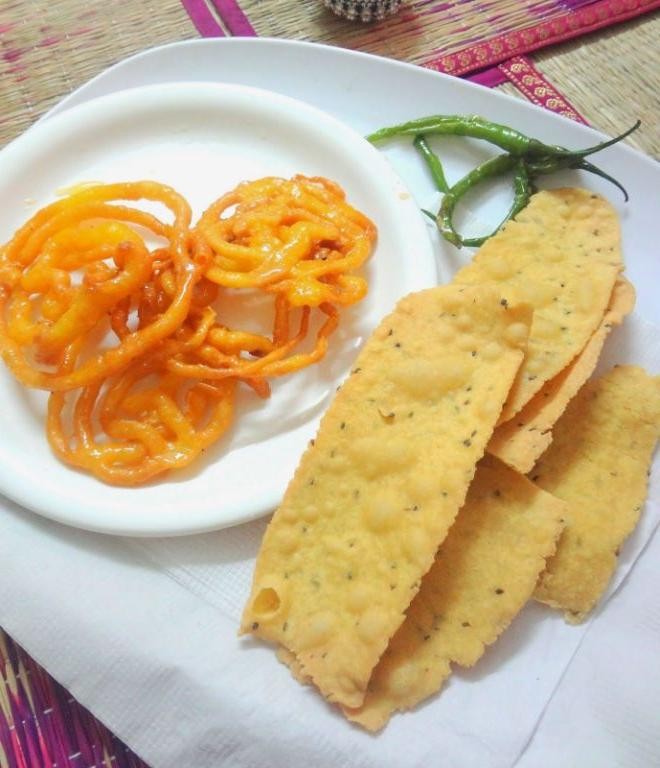
Yearning for a taste of Gujarat’s iconic snack? Fafda, a crispy, golden delight, is a testament to the simplicity and elegance of Indian street food, perfect for those who appreciate a crunchy, savory treat with their tea.
Ingredients
- For the dough:
- 2 cups gram flour (besan)
- 1/4 teaspoon turmeric powder
- 1/2 teaspoon carom seeds (ajwain)
- 1/4 teaspoon baking soda
- 2 tablespoons oil
- 1/2 cup water, or as needed
- Salt to taste
- For frying:
- Oil, for deep frying
Instructions
- In a large mixing bowl, combine gram flour, turmeric powder, carom seeds, baking soda, 2 tablespoons oil, and salt. Mix well to incorporate all the dry ingredients.
- Gradually add water to the mixture, kneading into a stiff dough. The dough should be firm enough to hold its shape when rolled out.
- Divide the dough into small portions. On a clean surface, roll each portion into a long, thin strip, about 1/4 inch thick and 4-5 inches long. Use oil on your palms to prevent sticking.
- Heat oil in a deep fryer or kadhai to 350°F over medium heat. Carefully slide the rolled dough strips into the hot oil.
- Fry the fafdas in batches, turning occasionally, until they are golden brown and crispy, about 3-4 minutes per batch. Avoid overcrowding the fryer to ensure even cooking.
- Remove the fafdas with a slotted spoon and drain on paper towels to remove excess oil.
Enjoy the fafdas warm, paired with a tangy green chutney or sweet jalebi for a contrast in flavors. Their crisp texture and aromatic spices make them an irresistible snack any time of the day.
Gujarati Kadhi
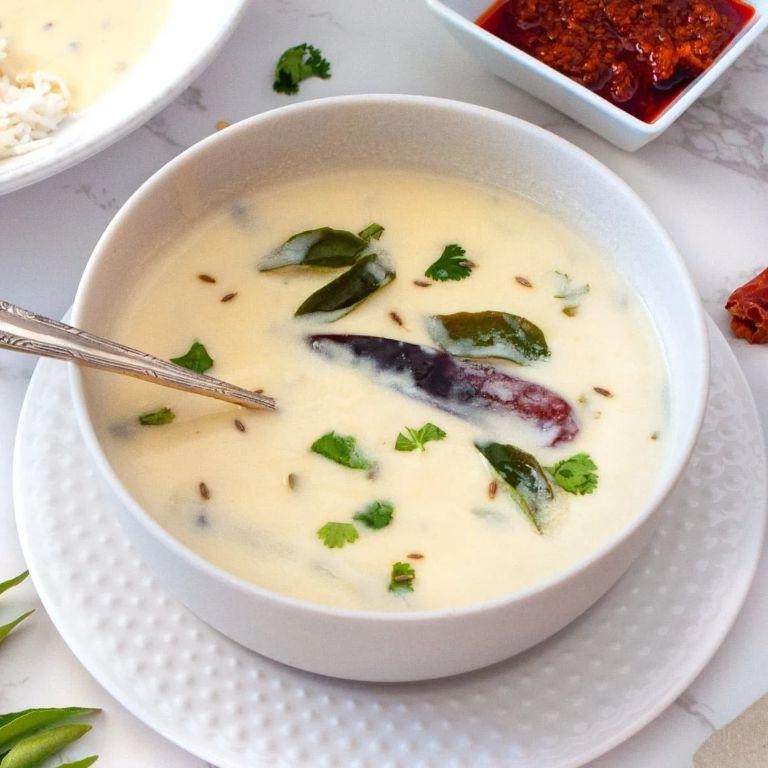
Elegantly spiced and soothingly tangy, Gujarati Kadhi is a comforting yogurt-based curry that embodies the essence of Gujarati cuisine, with its perfect balance of sweetness and spice.
Ingredients
- For the kadhi:
- 1 cup plain yogurt
- 3 cups water
- 1/4 cup chickpea flour (besan)
- 1 tbsp ginger paste
- 1 tbsp green chili paste
- 1 tsp turmeric powder
- 1 tbsp sugar
- Salt to taste
- For the tempering:
- 2 tbsp ghee
- 1 tsp mustard seeds
- 1 tsp cumin seeds
- 2 dried red chilies
- 10-12 curry leaves
- A pinch of asafoetida (hing)
Instructions
- In a large bowl, whisk together yogurt, water, and chickpea flour until smooth to prevent lumps.
- Add ginger paste, green chili paste, turmeric powder, sugar, and salt to the yogurt mixture, stirring well to combine.
- Heat the mixture over medium heat, stirring continuously for about 15 minutes until it thickens slightly; do not let it boil to avoid curdling.
- For the tempering, heat ghee in a small pan over medium heat. Add mustard seeds and cumin seeds, waiting until they crackle.
- Add dried red chilies, curry leaves, and asafoetida to the pan, sautéing for 30 seconds until fragrant.
- Pour the tempering over the kadhi, stirring gently to incorporate the flavors.
- Simmer the kadhi on low heat for another 5 minutes, allowing the flavors to meld together beautifully.
Hearty and aromatic, this Gujarati Kadhi boasts a velvety texture with a delightful interplay of tangy and sweet notes. Serve it steaming hot with steamed rice or khichdi for a soul-satisfying meal.
Dal Dhokli
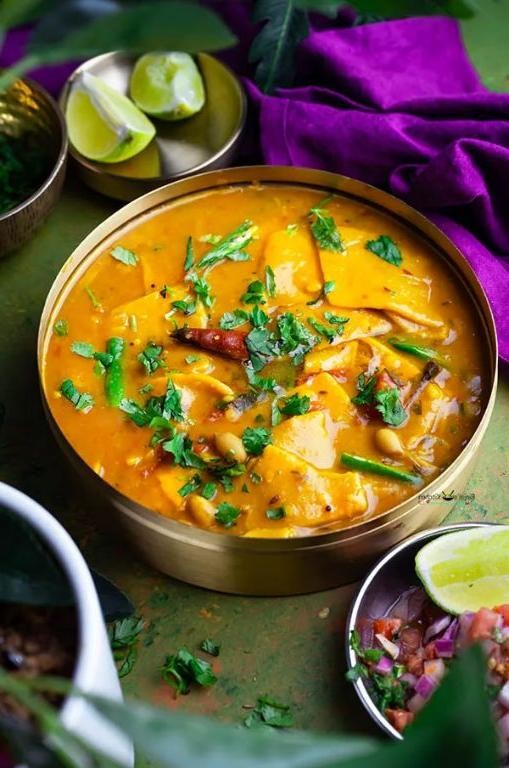
Savory and comforting, Dal Dhokli is a traditional Gujarati one-pot meal that marries the heartiness of lentils with the delicate texture of wheat flour dumplings, creating a dish that’s both nourishing and deeply satisfying.
Ingredients
- For the dal:
- 1 cup split pigeon peas (toor dal)
- 4 cups water
- 1 tsp turmeric powder
- 2 tbsp ghee
- 1 tsp cumin seeds
- 1/2 tsp asafoetida (hing)
- 2 green chilies, slit
- 1 tbsp ginger, grated
- 1/2 cup tomatoes, chopped
- 1 tsp salt
- 1 tbsp lemon juice
- 2 tbsp cilantro, chopped
- For the dhokli:
- 1 cup whole wheat flour
- 1/4 tsp turmeric powder
- 1/2 tsp red chili powder
- 1 tbsp ghee
- 1/4 cup water, or as needed
Instructions
- Rinse the toor dal under running water until the water runs clear.
- In a pressure cooker, combine the rinsed dal, water, and turmeric powder. Cook on high heat for 3 whistles, then reduce the heat to low and cook for another 10 minutes. Allow the pressure to release naturally.
- While the dal is cooking, prepare the dhokli dough by mixing whole wheat flour, turmeric powder, red chili powder, and ghee in a bowl. Gradually add water to form a stiff dough. Cover and set aside.
- Once the dal is cooked, mash it lightly with a spoon or whisk to achieve a slightly thick consistency.
- In a separate pan, heat ghee over medium heat. Add cumin seeds and let them splutter. Add asafoetida, green chilies, and grated ginger, sautéing for 30 seconds until fragrant.
- Add chopped tomatoes and salt to the pan, cooking until the tomatoes are soft and mushy.
- Pour the mashed dal into the pan with the tomato mixture, stirring well to combine. Bring to a gentle simmer.
- Roll out the dhokli dough into a thin sheet on a floured surface. Cut into diamond-shaped pieces.
- Drop the dhokli pieces into the simmering dal one by one, ensuring they don’t stick together. Cook for 10-12 minutes, or until the dhokli is tender.
- Stir in lemon juice and garnish with chopped cilantro before serving.
Fluffy and tender dhokli pieces soak up the aromatic dal, offering a delightful contrast in textures. Serve this hearty dish with a side of steamed rice or enjoy it as a standalone meal for a truly comforting experience.
Handvo
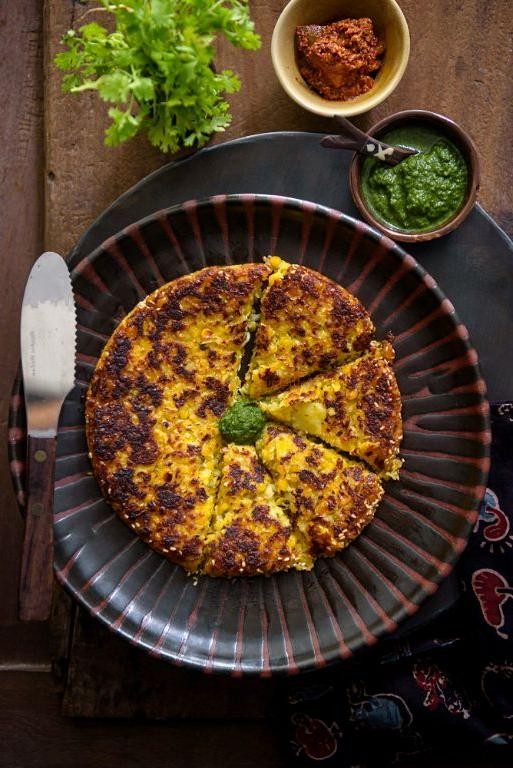
Gracefully bridging the gap between snack and meal, Handvo is a savory Gujarati cake that’s as nutritious as it is delicious, combining lentils, rice, and a medley of vegetables in a spiced, baked delight.
Ingredients
- For the batter:
- 1 cup rice
- 1/2 cup split yellow lentils (toor dal)
- 1/2 cup split green lentils (moong dal)
- 1/4 cup yogurt
- 1 tsp ginger paste
- 1 tsp green chili paste
- 1/2 tsp turmeric powder
- 1/2 tsp baking soda
- Salt to taste
- For the topping:
- 2 tbsp oil
- 1 tsp mustard seeds
- 1 tsp sesame seeds
- 2 tbsp grated coconut
- 2 tbsp chopped cilantro
Instructions
- Soak the rice and lentils together in water for 4-6 hours, then drain well.
- Blend the soaked rice and lentils with yogurt, ginger paste, green chili paste, turmeric powder, and salt into a smooth batter. Let it ferment overnight or for 8 hours.
- Preheat the oven to 350°F (175°C) and grease a baking dish with oil.
- Mix baking soda into the batter and pour it into the prepared dish.
- Heat oil in a small pan, add mustard seeds, and let them pop. Then add sesame seeds, grated coconut, and cilantro, sautéing for a minute.
- Spread the topping evenly over the batter and bake for 30-35 minutes, or until a toothpick inserted comes out clean.
- Let it cool for 10 minutes before slicing.
Amazingly versatile, Handvo boasts a crispy crust with a soft, fluffy interior, punctuated by the nuttiness of sesame and the freshness of cilantro. Serve it warm with a side of tangy tamarind chutney or enjoy it as is for a satisfying snack.
Patra
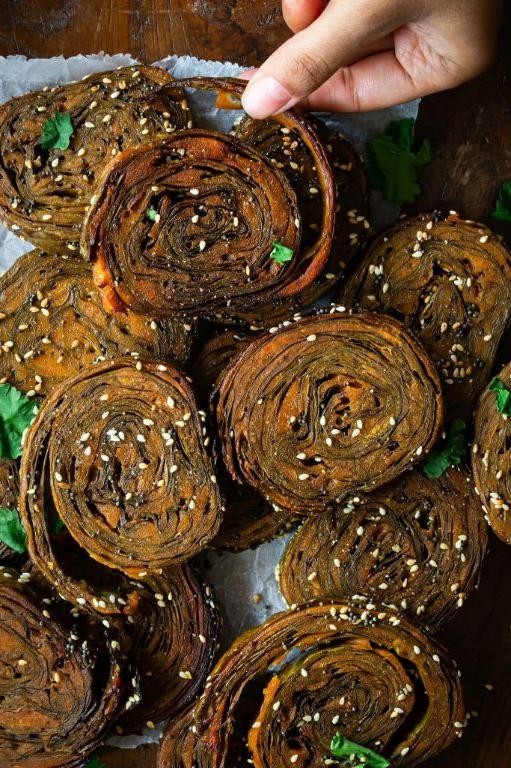
Vibrant and flavorful, Patra is a traditional Indian snack that combines the earthy taste of colocasia leaves with a sweet and tangy tamarind sauce, offering a delightful contrast of textures and flavors.
Ingredients
- For the batter:
- 1 cup gram flour (besan)
- 2 tbsp rice flour
- 1 tsp turmeric powder
- 1 tsp red chili powder
- 1 tsp ginger paste
- 1 tsp green chili paste
- 1/2 cup water
- Salt to taste
- For the filling:
- 12-15 colocasia leaves, cleaned and stems removed
- For the sauce:
- 1/2 cup tamarind pulp
- 1/4 cup jaggery, grated
- 1 tsp cumin seeds
- 1/2 tsp red chili powder
- 1/4 tsp asafoetida
- 2 tbsp oil
- Salt to taste
Instructions
- In a large bowl, mix gram flour, rice flour, turmeric powder, red chili powder, ginger paste, green chili paste, and salt. Gradually add water to form a smooth, thick batter.
- Lay a colocasia leaf flat on a surface. Spread a thin layer of the batter over the leaf. Place another leaf on top and repeat the process until you have a stack of 3-4 leaves.
- Roll the stack tightly from one end to the other, ensuring the batter seals the edges. Repeat with remaining leaves and batter.
- Steam the rolls in a steamer for 15 minutes on medium heat. Let them cool before slicing into 1/2-inch thick pieces.
- Heat oil in a pan over medium heat. Add cumin seeds and asafoetida, sautéing until fragrant. Stir in tamarind pulp, jaggery, red chili powder, and salt. Cook for 5 minutes until the sauce thickens.
- Add the sliced Patra to the sauce, gently tossing to coat each piece evenly. Cook for another 2 minutes.
- Serve warm, garnished with fresh cilantro if desired.
Soft yet slightly chewy, Patra offers a harmonious blend of sweet, spicy, and tangy flavors. For an innovative twist, serve these bite-sized rolls as part of a mezze platter alongside other Indian appetizers.
Gujarati Khichdi
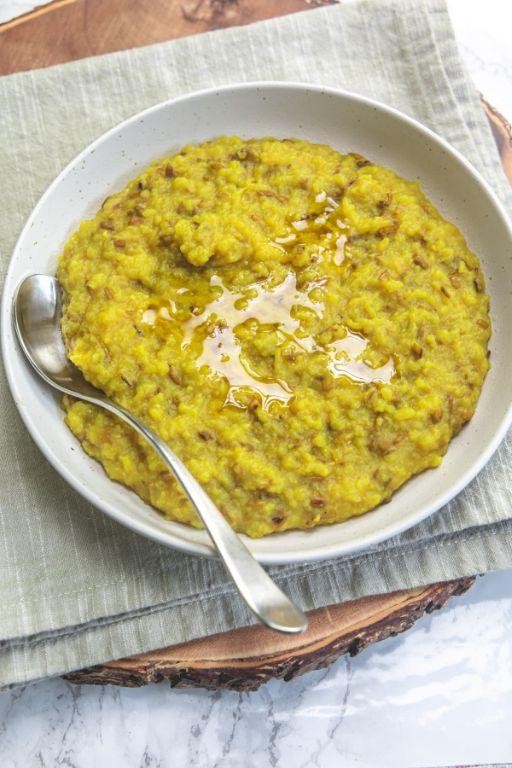
Just as the monsoon clouds gather over the horizon, a steaming bowl of Gujarati Khichdi offers the perfect comfort, blending the simplicity of lentils and rice with a melody of spices that sing of home.
Ingredients
- For the Khichdi:
- 1 cup basmati rice
- 1/2 cup split yellow moong dal
- 4 cups water
- 1 tbsp ghee
- 1/2 tsp turmeric powder
- 1/2 tsp asafoetida (hing)
- Salt to taste
- For the Tempering:
- 2 tbsp ghee
- 1 tsp cumin seeds
- 1/2 tsp mustard seeds
- 2 dried red chilies
- 1 sprig curry leaves
Instructions
- Rinse the basmati rice and moong dal together under cold water until the water runs clear. Soak them in water for 30 minutes, then drain.
- In a pressure cooker, heat 1 tbsp ghee over medium heat. Add the soaked rice and dal, stirring gently for 2 minutes to lightly toast.
- Add 4 cups water, turmeric powder, asafoetida, and salt. Stir well, then close the pressure cooker lid. Cook on high heat until the first whistle, then reduce to low and cook for another 10 minutes. Turn off the heat and let the pressure release naturally.
- For the tempering, heat 2 tbsp ghee in a small pan over medium heat. Add cumin seeds, mustard seeds, dried red chilies, and curry leaves. Fry until the seeds pop and the chilies darken, about 1 minute.
- Pour the tempering over the cooked khichdi and gently mix. Let it sit covered for 5 minutes to allow the flavors to meld.
Authentically comforting, this khichdi boasts a creamy texture with each grain of rice perfectly separate, enveloped in the warmth of ghee and spices. Serve it with a side of kadhi or a dollop of yogurt for a complete meal that soothes the soul.
Panki

Elegantly wrapped in banana leaves and steamed to perfection, Panki is a traditional Indian snack that offers a delicate balance of flavors and textures, making it a must-try for those seeking a unique culinary experience.
Ingredients
- For the batter:
- 1 cup rice flour
- 1/4 cup yogurt
- 1/2 tsp turmeric powder
- 1/2 tsp salt
- 1 cup water
- For greasing:
- 2 tbsp oil
- For serving:
- Fresh coriander leaves
- Green chutney
Instructions
- In a large bowl, combine rice flour, yogurt, turmeric powder, and salt. Gradually add water to form a smooth, lump-free batter. Tip: The consistency should be similar to pancake batter for the perfect Panki.
- Heat a non-stick pan over medium heat and lightly grease it with oil. Tip: Using a brush to apply oil ensures an even layer and prevents sticking.
- Pour a ladleful of batter onto the pan, spreading it gently into a thin circle. Cover and cook for 2 minutes, or until the edges start to lift.
- Carefully flip the Panki and cook for another 2 minutes, uncovered, until golden spots appear. Tip: The steam trapped under the lid helps cook the Panki evenly, so avoid peeking too soon.
- Transfer the cooked Panki to a plate lined with banana leaves for an authentic presentation. Repeat with the remaining batter.
- Serve hot, garnished with fresh coriander leaves and a side of green chutney.
Flaky yet soft, Panki delights with its subtle tanginess and earthy undertones, best enjoyed fresh off the pan. For a creative twist, try rolling them with a spicy potato filling for a hearty snack.
Gujarati Sev Tameta Nu Shaak
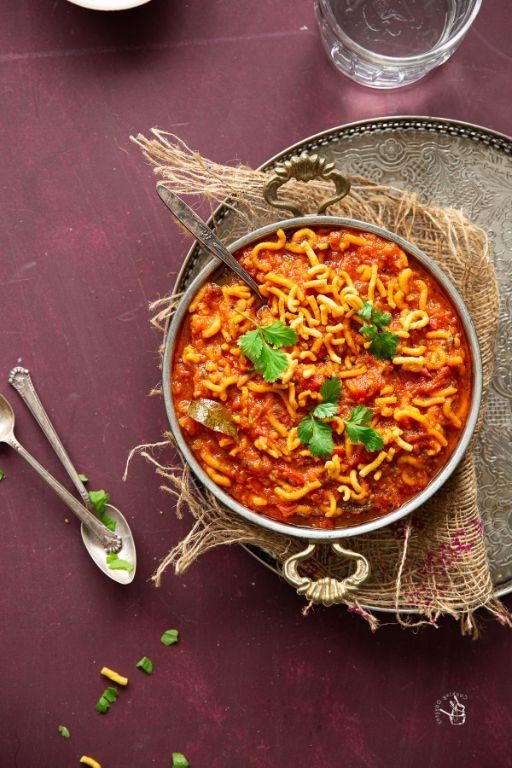
Zesty and vibrant, this Gujarati Sev Tameta Nu Shaak is a delightful exploration of flavors, combining the tanginess of tomatoes with the crunch of sev in a dish that’s as comforting as it is flavorful. Perfect for those who appreciate a meal that balances simplicity with depth, it’s a testament to the ingenuity of Gujarati cuisine.
Ingredients
- For the base:
- 2 tablespoons vegetable oil
- 1 teaspoon mustard seeds
- 1/2 teaspoon asafoetida (hing)
- 1 cup finely chopped onions
- 2 teaspoons ginger-garlic paste
- 4 cups diced tomatoes
- 1 teaspoon turmeric powder
- 1 tablespoon coriander powder
- 1 teaspoon red chili powder
- 1 teaspoon sugar
- Salt to taste
- For garnishing:
- 1 cup sev (thin gram flour noodles)
- 1/4 cup chopped cilantro
Instructions
- Heat 2 tablespoons of vegetable oil in a large pan over medium heat (350°F).
- Add 1 teaspoon mustard seeds and 1/2 teaspoon asafoetida to the oil, waiting until the seeds begin to pop, about 30 seconds.
- Stir in 1 cup of finely chopped onions and sauté until translucent, approximately 5 minutes.
- Mix in 2 teaspoons of ginger-garlic paste and cook for another minute, until fragrant.
- Add 4 cups of diced tomatoes, 1 teaspoon turmeric powder, 1 tablespoon coriander powder, 1 teaspoon red chili powder, 1 teaspoon sugar, and salt to taste. Cook uncovered for 10 minutes, stirring occasionally, until the tomatoes soften and the mixture thickens.
- Once the tomato mixture has reached a saucy consistency, remove from heat and transfer to a serving dish.
- Generously top with 1 cup of sev and garnish with 1/4 cup of chopped cilantro before serving.
Creating a harmonious blend of textures, the soft tomato base contrasts beautifully with the crispy sev, offering a dish that’s both hearty and light. Serve it alongside warm rotis or as a standalone snack, and watch as it becomes a conversation starter at any meal.
Methi Thepla
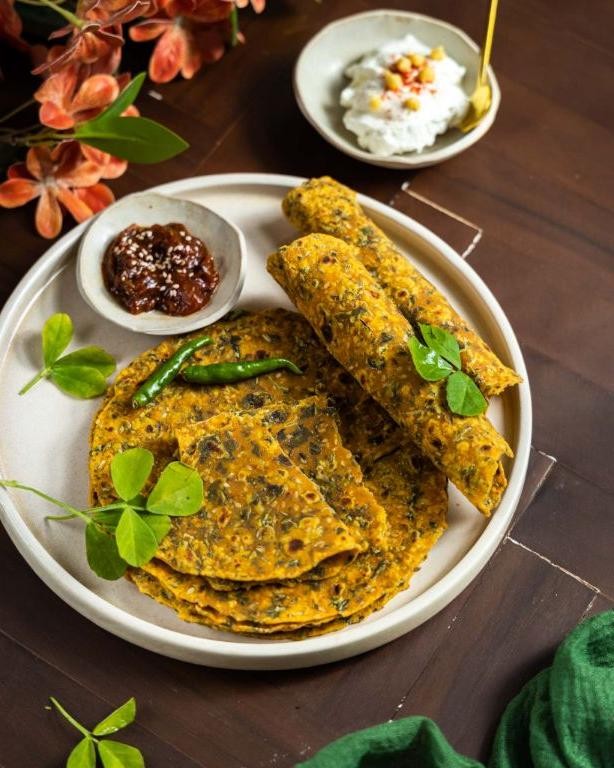
Perfectly blending the earthy bitterness of fenugreek leaves with the warmth of spices, Methi Thepla is a Gujarati flatbread that’s as nutritious as it is flavorful, offering a delightful way to incorporate greens into your diet.
Ingredients
- For the dough:
- 2 cups whole wheat flour
- 1/2 cup fresh fenugreek leaves, finely chopped
- 1/4 cup yogurt
- 2 tbsp oil
- 1 tsp turmeric powder
- 1 tsp red chili powder
- 1/2 tsp cumin seeds
- Salt to taste
- Water as needed
- For cooking:
- 2 tbsp oil for frying
Instructions
- In a large mixing bowl, combine whole wheat flour, chopped fenugreek leaves, yogurt, 2 tbsp oil, turmeric powder, red chili powder, cumin seeds, and salt.
- Gradually add water and knead into a soft, pliable dough. Cover and let it rest for 15 minutes to allow the flavors to meld.
- Divide the dough into equal portions and roll each into a ball. On a floured surface, roll each ball into a thin, round flatbread about 6 inches in diameter.
- Heat a skillet over medium heat and place a rolled thepla on it. Cook for 1 minute or until small bubbles appear on the surface.
- Flip the thepla, spread 1/2 tsp oil on the top side, and cook for another minute. Flip again, spread oil on the other side, and cook until both sides are golden brown with crisp edges.
- Repeat the process with the remaining dough balls, stacking the cooked theplas on a plate covered with a clean cloth to keep them soft.
Zesty and slightly crisp, Methi Thepla pairs wonderfully with a dollop of yogurt or pickle. For a creative twist, serve it rolled with a filling of spiced potatoes or paneer for a satisfying meal on the go.
Gujarati Muthia
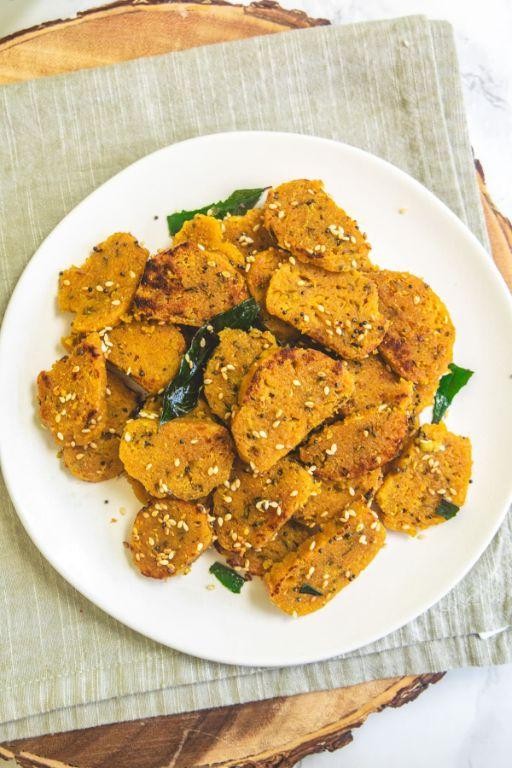
Gujarati Muthia, a steamed and then sautéed delight, embodies the essence of Gujarat’s vegetarian cuisine with its harmonious blend of spices and textures. This dish, often enjoyed as a snack or side, showcases the simplicity and depth of flavors that Indian cooking is celebrated for.
Ingredients
- For the dough:
- 1 cup whole wheat flour
- 1/2 cup besan (gram flour)
- 1/4 cup finely chopped fenugreek leaves
- 1 tbsp ginger-green chili paste
- 1/2 tsp turmeric powder
- 1/2 tsp red chili powder
- 1/2 tsp cumin seeds
- 1 tbsp oil
- 1/4 cup water (approx.)
- Salt to taste
- For tempering:
- 2 tbsp oil
- 1/2 tsp mustard seeds
- 1/2 tsp sesame seeds
- A pinch of asafoetida
- 2 tbsp grated coconut (optional)
- 2 tbsp chopped cilantro for garnish
Instructions
- In a large bowl, combine whole wheat flour, besan, fenugreek leaves, ginger-green chili paste, turmeric powder, red chili powder, cumin seeds, 1 tbsp oil, and salt. Mix well.
- Gradually add water and knead into a firm dough. Cover and let it rest for 10 minutes.
- Divide the dough into equal portions and roll each into a cylindrical shape, about 1/2 inch in diameter.
- Steam the rolls in a steamer for 15 minutes on medium heat. Tip: Ensure the steamer is preheated to avoid sogginess.
- Once steamed, let them cool slightly, then cut into 1/2 inch pieces.
- Heat 2 tbsp oil in a pan. Add mustard seeds, sesame seeds, and asafoetida. Let them splutter.
- Add the steamed pieces to the pan and sauté on medium heat until they turn golden brown, about 5-7 minutes. Tip: Stir occasionally for even browning.
- Garnish with grated coconut and chopped cilantro before serving. Tip: For an extra crunch, sprinkle some sesame seeds on top.
Here, the muthia boasts a soft interior with a slightly crisp exterior, offering a delightful contrast in textures. Serve it warm with a side of tangy tamarind chutney or as a unique addition to your breakfast platter for a touch of Gujarati flair.
Gujarati Dal
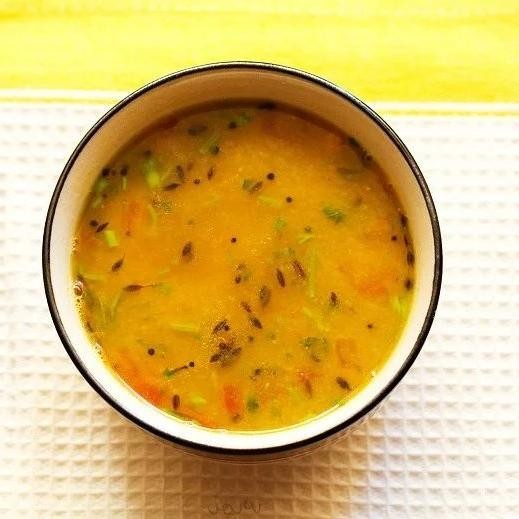
Warm, comforting, and brimming with the vibrant flavors of Gujarat, this dal is a testament to the simplicity and depth of Indian home cooking. Its golden hue and aromatic spices invite you into a world where every spoonful is a blend of tradition and taste.
Ingredients
- For the dal: 1 cup toor dal, 4 cups water, 1/2 tsp turmeric powder
- For the tempering: 2 tbsp ghee, 1 tsp cumin seeds, 2 dried red chilies, 1/2 tsp asafoetida, 1 tbsp ginger-garlic paste, 1 cup chopped tomatoes, 1 tsp salt, 1 tsp sugar, 1/2 tsp garam masala, 2 tbsp chopped cilantro
Instructions
- Rinse the toor dal under cold water until the water runs clear, then drain.
- In a pressure cooker, combine the rinsed dal, 4 cups of water, and turmeric powder. Secure the lid and cook on high heat until the first whistle, then reduce to low and cook for another 15 minutes. Let the pressure release naturally.
- While the dal cooks, heat ghee in a pan over medium heat for the tempering. Add cumin seeds and let them sizzle for about 30 seconds until fragrant.
- Add dried red chilies and asafoetida to the pan, stirring for another 30 seconds to release their flavors.
- Stir in the ginger-garlic paste and sauté for 1 minute until the raw smell disappears.
- Add chopped tomatoes, salt, and sugar to the pan. Cook for 5 minutes, stirring occasionally, until the tomatoes soften and the mixture thickens slightly.
- Once the dal is cooked, mash it lightly with a spoon for a creamy texture, then stir in the tomato mixture and garam masala. Simmer together for 5 minutes to blend the flavors.
- Garnish with chopped cilantro before serving.
Creamy yet light, this Gujarati dal is a harmonious blend of sweet, spicy, and tangy notes. Serve it over steamed rice or with warm rotis for a meal that comforts and satisfies in equal measure.
Batata Nu Shaak

Kindly reminiscent of the vibrant streets of Gujarat, Batata Nu Shaak is a comforting potato curry that marries simplicity with depth, offering a symphony of flavors that are both earthy and subtly spiced.
Ingredients
- For the curry:
- 2 large potatoes, peeled and diced into 1-inch cubes
- 2 tbsp vegetable oil
- 1 tsp mustard seeds
- 1/2 tsp turmeric powder
- 1 tsp cumin seeds
- 1 green chili, finely chopped
- 1 tsp ginger, grated
- 1/2 tsp sugar
- 1 tsp lemon juice
- Salt, 1 tsp or to taste
- 1/2 cup water
- 2 tbsp cilantro, chopped for garnish
Instructions
- Heat 2 tbsp vegetable oil in a large skillet over medium heat until shimmering, about 1 minute.
- Add 1 tsp mustard seeds and 1 tsp cumin seeds to the oil, stirring until they begin to pop, about 30 seconds.
- Stir in 1 green chili and 1 tsp grated ginger, sautéing for another 30 seconds until fragrant.
- Add the diced potatoes to the skillet, along with 1/2 tsp turmeric powder, 1 tsp sugar, and 1 tsp salt, tossing to coat evenly.
- Pour in 1/2 cup water, cover the skillet, and reduce the heat to low. Simmer for 15-20 minutes, or until the potatoes are tender.
- Uncover, stir in 1 tsp lemon juice, and cook for an additional 2 minutes to allow the flavors to meld.
- Garnish with 2 tbsp chopped cilantro before serving.
Offering a delightful contrast between the soft, yielding potatoes and the crispness of the mustard seeds, Batata Nu Shaak is best enjoyed with warm rotis or as a hearty side to a traditional Gujarati thali.
Gujarati Khaman
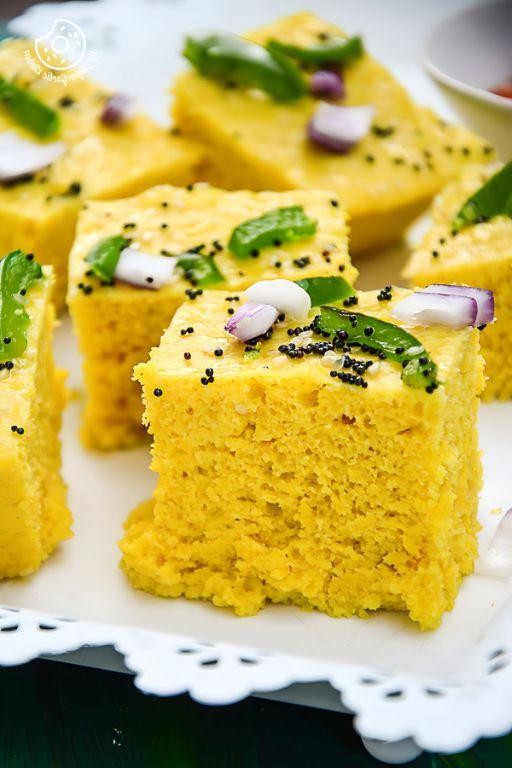
Fluffy, light, and bursting with tangy flavors, Gujarati Khaman is a steamed chickpea flour cake that’s a staple in Indian cuisine, offering a delightful balance of sweet and savory notes.
Ingredients
- For the batter:
- 1 cup chickpea flour
- 1 tbsp semolina
- 1 tsp ginger-green chili paste
- 1/2 tsp turmeric powder
- 1 tbsp lemon juice
- 1 tsp sugar
- 1/2 tsp baking soda
- 1 cup water
- For the tempering:
- 2 tbsp oil
- 1 tsp mustard seeds
- 1 tsp sesame seeds
- 2 green chilies, slit
- 1/2 cup water
- 2 tbsp sugar
- 1 tbsp lemon juice
- Fresh cilantro, chopped (for garnish)
Instructions
- In a large bowl, whisk together chickpea flour, semolina, ginger-green chili paste, turmeric powder, lemon juice, sugar, and water to form a smooth batter. Let it rest for 10 minutes.
- After resting, add baking soda to the batter and mix gently. The batter will become frothy.
- Pour the batter into a greased steamer plate and steam over medium heat for 15 minutes, or until a toothpick inserted comes out clean.
- While the Khaman is steaming, heat oil in a small pan for the tempering. Add mustard seeds and let them pop.
- Add sesame seeds and green chilies to the pan, sauté for a few seconds until fragrant.
- Pour in water, sugar, and lemon juice, stirring until the sugar dissolves. Bring to a boil, then simmer for 2 minutes.
- Once the Khaman is steamed, pour the tempering evenly over it. Garnish with chopped cilantro.
- Let it sit for 5 minutes to absorb the flavors before cutting into squares.
Khaman’s spongy texture and the interplay of sweet, tangy, and spicy flavors make it irresistible. Serve it warm, garnished with sev and coconut for an extra crunch, or enjoy it as is for a light, satisfying snack.
Gujarati Chana Dal
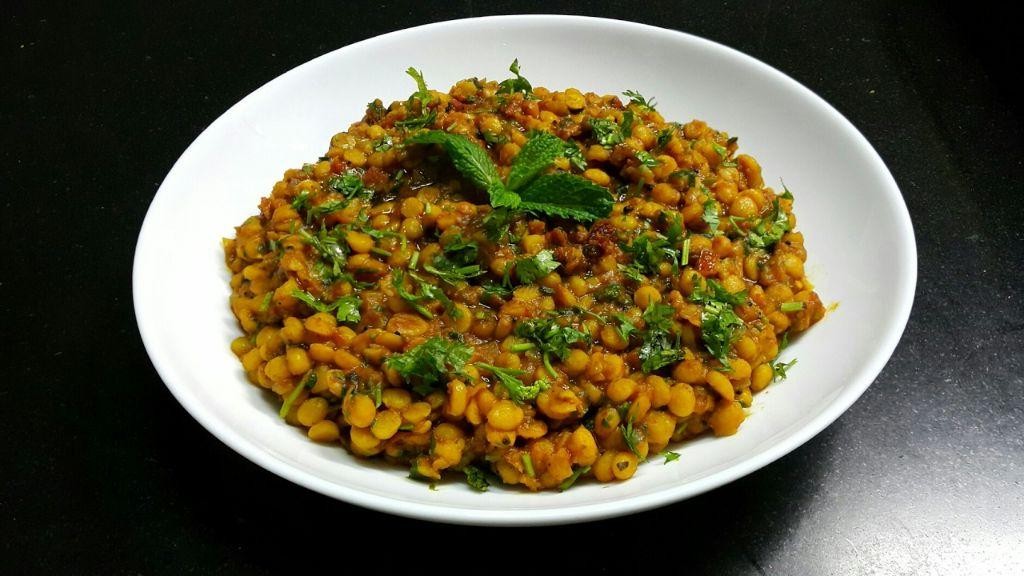
Lusciously aromatic and deeply comforting, Gujarati Chana Dal is a testament to the simplicity and vibrancy of Indian cuisine, where humble lentils are transformed into a dish brimming with warmth and flavor.
Ingredients
- For the dal:
- 1 cup chana dal (split Bengal gram), rinsed and soaked for 30 minutes
- 4 cups water
- 1/2 tsp turmeric powder
- 1 tsp salt
- For the tempering:
- 2 tbsp ghee
- 1 tsp cumin seeds
- 1 medium onion, finely chopped
- 2 green chilies, slit
- 1 tbsp ginger-garlic paste
- 1 large tomato, finely chopped
- 1/2 tsp red chili powder
- 1/2 tsp garam masala
- 1 tbsp lemon juice
- 2 tbsp fresh cilantro, chopped
Instructions
- In a pressure cooker, combine the soaked chana dal, water, turmeric powder, and salt. Cook on high heat for 3 whistles, then reduce the heat to low and cook for another 10 minutes. Let the pressure release naturally.
- Heat ghee in a pan over medium heat. Add cumin seeds and let them splutter for about 30 seconds, releasing their aroma.
- Add the chopped onion and green chilies to the pan. Sauté until the onions turn translucent, about 3-4 minutes.
- Stir in the ginger-garlic paste and sauté for another minute until the raw smell disappears.
- Add the chopped tomatoes, red chili powder, and garam masala. Cook until the tomatoes are soft and the oil begins to separate, about 5 minutes.
- Pour the cooked dal into the pan with the tempering. Mix well and simmer for 5 minutes to allow the flavors to meld.
- Finish with lemon juice and garnish with fresh cilantro before serving.
Offering a creamy texture with a hint of tanginess, this Gujarati Chana Dal pairs beautifully with steamed rice or warm rotis, making it a versatile dish that’s as nourishing as it is delightful.
Gujarati Aloo Puri
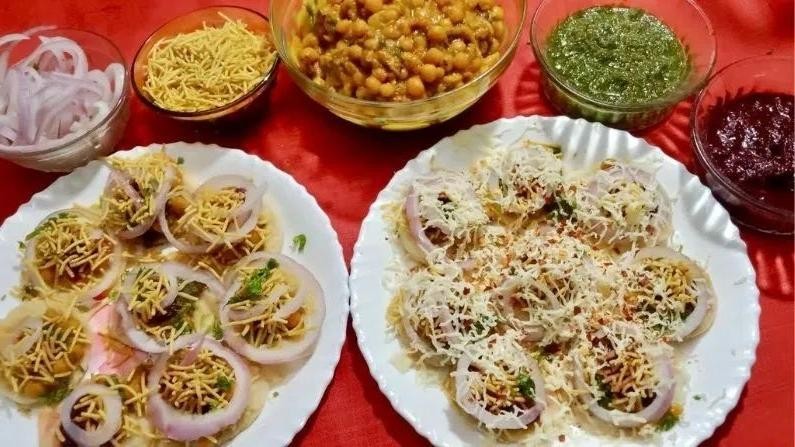
Zesty and vibrant, Gujarati Aloo Puri is a beloved dish that marries fluffy, deep-fried bread with a spiced potato curry, offering a symphony of textures and flavors that are both comforting and exhilarating.
Ingredients
- For the Puri:
- 2 cups whole wheat flour
- 1/2 tsp salt
- 2 tbsp vegetable oil
- 3/4 cup water, approximately
- For the Aloo Curry:
- 3 medium potatoes, peeled and diced
- 2 tbsp vegetable oil
- 1 tsp mustard seeds
- 1/2 tsp turmeric powder
- 1 tsp cumin powder
- 1 tsp coriander powder
- 1/2 tsp red chili powder
- 1 tbsp lemon juice
- 1/2 cup water
- Salt to taste
- Fresh cilantro for garnish
Instructions
- In a large bowl, mix the whole wheat flour, salt, and vegetable oil. Gradually add water to form a stiff dough. Knead for 5 minutes until smooth. Cover and let it rest for 30 minutes.
- Divide the dough into small balls. Roll each ball into a 4-inch circle on a lightly floured surface.
- Heat oil in a deep fryer or kadai to 350°F. Fry each puri until puffed and golden, about 30 seconds per side. Drain on paper towels.
- For the aloo curry, heat oil in a pan over medium heat. Add mustard seeds and wait until they pop.
- Add the diced potatoes, turmeric, cumin, coriander, and red chili powder. Stir well to coat the potatoes with the spices.
- Pour in water, cover, and simmer for 10 minutes or until potatoes are tender. Stir occasionally to prevent sticking.
- Uncover, add lemon juice and salt. Cook for another 2 minutes to let the flavors meld. Garnish with fresh cilantro.
Fluffy puris paired with the tangy and spicy aloo curry create a dish that’s irresistibly delicious. Serve them hot for a breakfast that’s both hearty and satisfying, or as a festive meal that’s sure to impress.
Gujarati Bharela Marcha
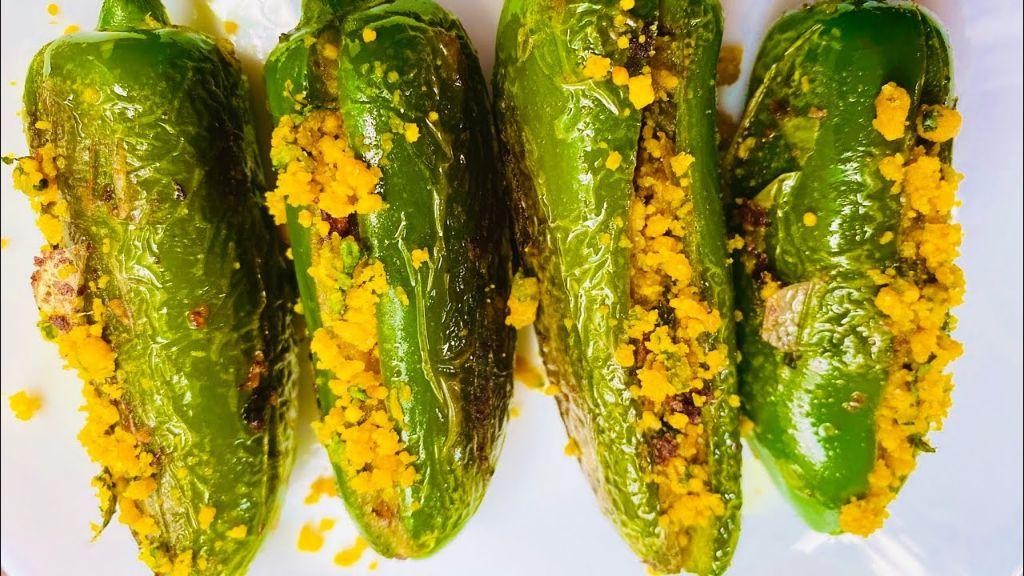
Fragrant and vibrant, Gujarati Bharela Marcha is a stuffed chili dish that marries the heat of green chilies with a sweet and tangy peanut filling, offering a delightful contrast of flavors.
Ingredients
- For the stuffing:
- 1 cup roasted peanuts, finely ground
- 2 tbsp jaggery, grated
- 1 tsp cumin powder
- 1/2 tsp turmeric powder
- 1 tbsp lemon juice
- Salt to taste
- For the chilies:
- 8 large green chilies, slit lengthwise and deseeded
- 2 tbsp oil
Instructions
- In a mixing bowl, combine the ground peanuts, jaggery, cumin powder, turmeric powder, lemon juice, and salt to create the stuffing mixture.
- Gently stuff each chili with the peanut mixture, ensuring they are evenly filled without breaking.
- Heat oil in a pan over medium heat (350°F) and carefully place the stuffed chilies in the pan.
- Cook the chilies for 3-4 minutes on each side or until they are lightly charred and the stuffing is golden brown.
- Remove the chilies from the pan and place them on a paper towel to drain any excess oil.
Just as the first bite offers a crunch from the peanuts, the following flavors unfold with the sweetness of jaggery and the tanginess of lemon, making it a perfect side dish or a standalone snack. Serve them warm with a drizzle of tamarind chutney for an extra layer of flavor.
Conclusion
We hope this roundup of 20 authentic Gujarati recipes brings a taste of India’s vibrant flavors to your kitchen. Each dish is a celebration of tradition and taste, perfect for home cooks eager to explore. Don’t forget to try these recipes, share your favorites in the comments, and pin this article on Pinterest to spread the joy of Gujarati cooking. Happy cooking!
